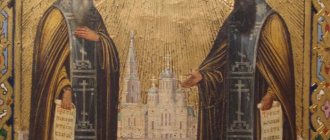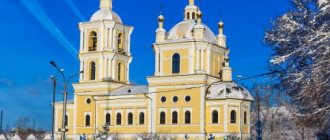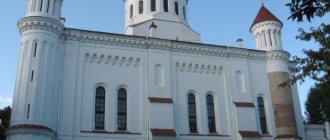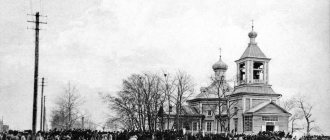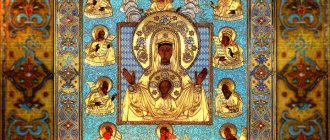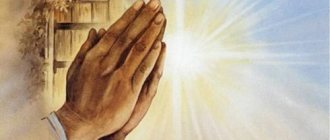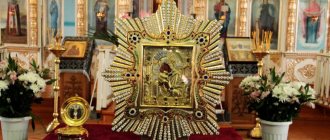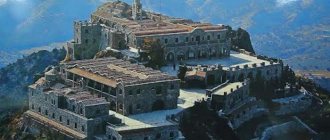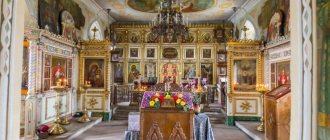History of the appearance of the image
The fire-shaped icon differs significantly from other images of the Virgin Mary.
Three elements are noteworthy:
- absence of the Baby Jesus;
- color scheme of clothing;
- facial expression and gaze.
There is no exact information about this prototype of the Heavenly Patroness. It is assumed that it was painted by a Greek icon painter in the middle of the 9th century. The name of the icon and the appearance of the Most Pure Virgin Mary correlate with the words from the canon “...Fire-shaped Chariot of the Word”, as well as with epithets from chants, where she is called “Candlestick of Divine Fire”, “Throne of Cherubic Fire”.
The red robe of the Mother of God in this case is a symbol of the cleansing fire and blood of the Savior, shed in the name of the human race. The combination of bright colors in clothing and a meek, humble look influences a person’s subconscious and causes an involuntary emotional response. The greatest distribution of image lists occurs in the 12th-15th centuries.
Icon color scheme
The red robe of the Virgin Mary symbolizes the blood of Jesus Christ, shed by Him in the name of the atoning sacrifice for all people. Is it a fiery color? a symbol of a cleansing fire that burns in our souls the tares of evil sown by the enemy of the human race. In Orthodox prayers and chants, the Most Holy Theotokos is often called the “Candlestick with Divine Fire” and the “Throne of Cherubic Fire.” In the canon written in Her honor, the Mother of God is likened to the “Fire-like Chariot of the Word.”
Looking at the icon, one cannot help but pay attention to the gaze of the Mother of God. He is addressed directly to us and is filled with meekness and humility, as if penetrating the soul of the viewer. This feature is very characteristic of Byzantine icons, devoid of external emotionality. In this case, the emotional impact is created by the rich red color.
The meaning of the Fire Icon in Orthodoxy
Orthodox Christians venerate and love the miraculous images of the Mother of God. For centuries, they defended the Russian land from enemy invasions and performed miraculous healings. The fire-shaped icon was painted before the Baptism of Rus'. It became most widespread in Byzantium. The Russian Orthodox Church recognized and glorified the Divine face after the 18th century.
The Fire-shaped Mother of God is one of the images revered by the Old Believers, as an example of Byzantine icon painting.
Old Believers believe that the official church broke away from the true ancient Orthodox faith starting in the second half of the 17th century. For this reason, they consider themselves defenders of ancient Russian and Byzantine canons. The first list of “Ognevidnaya” in Russia was made in 1812, which is documented. It was included in the Orthodox calendar in 1815.
Fire-shaped icon of the Mother of God: what helps
By analogy with many other faces of the Blessed Virgin Mary, Christians offer prayers to the image of the Fire-like Mother of God with a request to protect them in any endeavors and affairs. In addition, it is customary to ask the icon to heal a person from various pathologies, protect him from negative influences from the outside, help successfully give birth to a healthy baby, and it is also believed that the face allows you to stop the war and save the lives of soldiers.
By offering a sincere prayer at the “Fire-shaped” icon of the Mother of God, you can be convinced that it works real miracles. There are known confirmations from contemporaries who say that children for whom they prayed at the image were healed even from the most serious pathologies and regained health.
It is noteworthy that the church does not have any special prayer for this face. This means that you can easily use any prayer addressed to the Holy Virgin Mary. And for it to really help you, one important condition must be met: the prayer must be sincere and come from a pure heart and soul. And before you start making appeals, we advise you to sincerely repent of all the sins you have committed.
What do they pray for in front of the image?
A merciful petitioner before the Lord for sinners will not leave without support if they approach her with pure thoughts and sincere faith in the power of prayer and God.
At the face of the Fire-shaped Mother of God, Orthodox believers ask:
- Help in any matter, from business projects to apartment renovations.
- Cures from diseases, including infertility, and depression.
- Protection from the actions and thoughts of ill-wishers and envious people.
- Cessation of hostilities.
Mothers, wives, sisters pray to the Most Holy Theotokos so that their sons, husbands and brothers return home from the war and recover from their wounds. Mothers of sick children turn to the miraculous image so that the Queen of Heaven will ask the Almighty for healing for children suffering from serious illnesses. We must remember that before praying, we must repent of our own sins and forgive our enemies.
What secret does the icon of the Virgin Mary keep?
Not much information is known about the history of the creation of this Divine Face, which forces us to draw any conclusions on this matter with great caution.
Find out what awaits you today - Horoscope for today for all zodiac signs
Who and when was the first to create the original copy of this Orthodox creation is not known for certain today. We can only say with complete certainty that the first version of the icon (now, unfortunately, it has already been lost) was created in 845.
Based on the information we have, we can conclude that the iconographic type of the icon evokes associations with the image of “Agiosortissa,” that is, “Intercessor and Petitioner.” The spread of this image occurs during the period from the twelfth to the fifteenth centuries. The spread of the image took place throughout the territory of Byzantium, and its homeland, most likely, is Greece.
At the same time, initially the icon showed us the face of the Holy Virgin Mary, who is holding in her hands not the Savior, but a scroll. The manuscript was a list of petitions for sinful people with which the Mother of God addressed her Son.
Thanks to this, we receive hope that the face of the Mother of God, similar to all other images of the Mother of God, helps protect people from any misfortunes and difficulties in life.
Due to numerous requests from readers, we have prepared an “Orthodox Calendar” application for smartphones. Every morning you will receive information about the current day: holidays, fasts, days of remembrance, prayers, parables. Download for free: Orthodox Calendar 2022 (available on Android)
As a result, it is customary to pray at the face of the icon of the Fire-like Mother of God about what goes beyond the limits of human abilities and for which help from above is truly needed.
Text of prayer in front of the fire icon
Traditional Theotokos prayers are offered in front of the icon, since there is no special prayer, just like the akathist. Most often, this is a prayer written for the “Bogolyubskaya” icon, which in iconography is close to the “Fire-shaped” one. They both belong to the “Intercessor and Helper” image type.
“Oh, Most Pure Lady Theotokos, God-loving Mother, Hope of our salvation! Look mercifully at those who come with faith and love and worship Your most pure image: accept our singing of praise and pour out Your warm prayer for us sinners to the Lord, that, having despised all our sins, He will save and have mercy on us! O Precious Lady! Show us Your wonderful mercies. We pray to You with tenderness, deliver us from all sorrow, guide us on the path of all virtues and goodness, save us from temptations, troubles and illnesses, take away slander and quarrels from us; save from lightning thunder, from burning fire, from famine, cowardice, flood and deadly plagues; Give us Your merciful help on the way, in the sea and on land, so that we may not perish violently. Oh, All-Merciful, God-loving Mother, with firm hope we send our humble prayer to You! Do not reject our tears and sighs, do not forget us all the days of our lives, but always remain with us, and through Your intercession and intercession with the Lord, give us joy, consolation, protection and help, so that we may glorify and magnify Your most blessed and all-sung name. Amen".
Icon of the Mother of God Fire-shaped: what they pray for
As noted earlier, the image of the Mother of God is able to protect a person from disease, bloodshed and military action. They pray at the face, asking to preserve (restore) the health and life of the defenders of the fatherland and soldiers. For this reason, it is not surprising that the icon is most popular among the mothers and sisters of those serving in combat zones. They are begging for help to end any fights as soon as possible and allow their sons and brothers to return home alive and unharmed.
In any case, no matter which of the faces of the Mother of God we consider and no matter what we call her, in reality we offer prayers not to the image itself, but directly to the Holy Virgin. This means that you may well turn to the Mother of God with a request to protect you from any misfortunes and troubles; the most important thing is that the prayer comes from a pure heart and is sincere.
What prayers to offer in front of the icon
The first icon of the Mother of God “Fire-shaped” mentioned in historical documents was painted in 1812. It was included in the Orthodox calendar three years later. This explains that in the Orthodox prayer book there is no prayer composed specifically for this image. The Akathist to the Fire-Shaped Icon of the Mother of God also does not exist. Therefore, the usual Mother of God prayers are offered before this icon.
Most often they read the prayer that was written for the icon called “Bogolyubskaya”. She, like the “Fire-shaped” icon of the Mother of God, in its iconographic type goes back to the “Agiosoritissa” icon? “Intercessor and Helper”, which was mentioned above. It received its name from the name of the pious Russian prince, who was honored to see in a dream the Most Holy Theotokos holding a scroll of petitions in her right hand and extending her left hand to Jesus Christ.
Grace poured out by faith
There is a lot of information that the “Fire-shaped” icon of the Mother of God did not leave unanswered prayers addressed to her with faith and humility. Without this, it is impossible to receive help from above. Remembering the Gospel words of Jesus Christ that we receive everything we ask only by the strength of our faith, they can undoubtedly be attributed to the grace poured out through the image called the “Fire-shaped” icon of the Mother of God. People turn to her for help during childbirth, and also pray for healing for children’s illnesses. In addition, they ask for a speedy end to wars and to save the lives of Orthodox soldiers.
It is no coincidence that in our country the “Fire-shaped” icon of the Mother of God is associated with military themes. Its meaning takes on a new shade due to the fact that the memory of the icon is celebrated on February 23, when our country celebrates Defender of the Fatherland Day. From her admirers we sometimes hear the words that the figure of a baby is missing on this icon precisely because with her own hands the Most Holy Theotokos is ready to accept into the arms of all the children of Christ scorched by the war.
Conclusions based on the study of the icon
Studying the iconographic features of this image and trying to reconstruct the history of its appearance, researchers are faced with a curious fact. From the documents that have reached us, it is clear that its primary source, from which all subsequent lists were made, came to the Russian lands in 845. Since the year of the Baptism of Rus' is considered to be 989, it follows that the icon appeared a century and a half earlier.
This fact may indicate that the Christian faith penetrated into Rus' long before its official adoption. Obviously, this happened in the first years of the reign of the Rurik dynasty. Nevertheless, the “Fire-shaped” icon of the Mother of God received its distribution in lists and veneration only in the 18th century.
